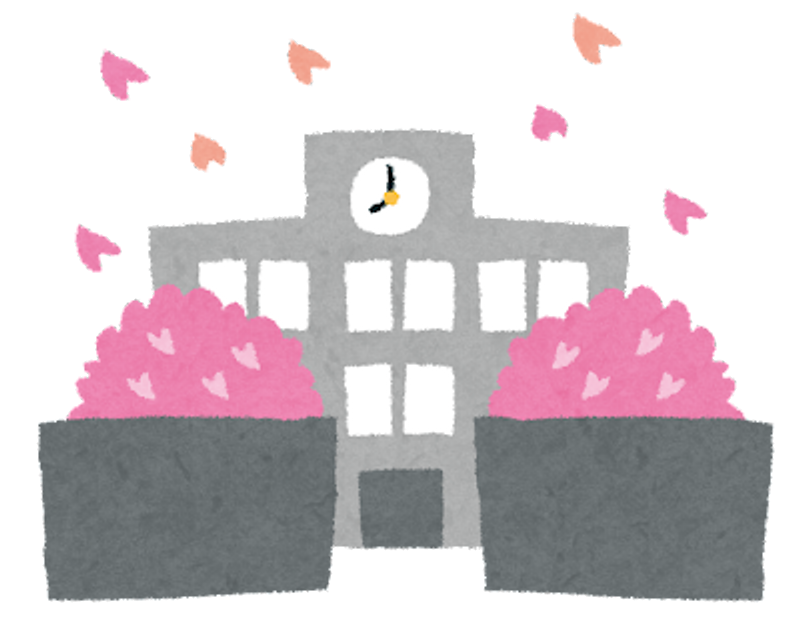Apr 8, 2022
The Japanese Academic Year

Here's hoping the cherry blossoms hang on to greet new students, image Irasutoya
The beginning of the school year is a time of excitement and nerves. Parents hope their kids will fit in and excel. Teachers wonder how they will get their classes to gel as a unit. And children get excited about seeing their friends. For non-Japanese teachers, some of the academic year events are familiar, others novel.
Before school opens, teachers are busy preparing. Administrations decide class schedules and teacher assignments. A big event in our staff room is 席替え, sekigae, or seat reassignment. As soon as we teachers find our desks and get our mitts on schedules, we start planning our days, weeks, months, and terms.
Many public and private schools operate on a three-term schedule. The first term starts with 始業式, shigyoshiki, an opening ceremony. Depending on the school and the effects of the ongoing pandemic mitigation measures, this could be a whole-school assembly, a broadcast over the school’s public address system, or an online presentation. New teachers may have to make a brief 自己紹介, jikoshokai, a self-introduction.
Depending on your grade assignment, you may not have lessons right away as 新入生 shinnyusei, or freshmen, have school life orientations. This year in addition to the usual introduction to school life, my students will learn how to use the Learning Management System and digital tools as Japan’s schools pivot to online education.
April is a time to get to know your students’ interests and needs, and setting the tone for the school year. A message from a senior educator influences every new school I start. He said that April is diagnostic, and that the Golden Week break that spans the end of April and early May is a time for teachers to reflect and regroup according to the needs of their classes.
In both public and private schools, 一学期, ichigakki, the first term, is an intense period of study from April until July. Non-Japanese teachers may be charged with preparing students for the first round of the Eiken, the widely-used English assessment test. The first session occurs in late May and early June. Non-Japanese teachers can learn about how to prepare students for the Eiken interviews.
Schools also host all-day events in this first term. Many elementary schools schedule their 運動会 undokai or sports festival which is often called 体育祭taiikusai at junior and senior high schools. Preparation and practice for this all day event may cancel your lessons. On the big day all kinds of track and field and fun events involve teachers, students, and parents, too. Genkidesu shared a parent’s perspective about preschool sports day.
Of course, testing will have an impact on your schedule. The 中間テスト chukan tesuto, midterm tests can interrupt regular lessons for a few days. Some schools have 単元テスト tangentesuto conducted in lessons. But virtually all schools will have 期末テスト, kimatsu tesuto, or final tests, often followed by 採点日 saitenbi, a grading day. Students often have home study, 家庭学習 katei gakushu. The term will wrap up with 終業式, shugyoshiki, a closing ceremony.
And so begins the summer break. An issue that comes up for Assistant Language Teachers (ALTs) is the inconsistency of the job duties, often referred to as ESID, Every Situation is Different. This lack of standard conditions affects the duties (or lack of duties) over the summer break. Your situation may determine whether you must use 年休 nenkyuu paid leave, or simply enjoy your off-campus time.
Here’s hoping that when school returns in September for 二学期 term 2, you’re refreshed and ready for another hectic period at school that concludes before the 冬休み fuyu yasumi, winter holiday. During term 2, schools hold culture festivals variously referred to as 学園祭 gakuensai or 文化祭 bunkasai. Like the sports days, a frenzy of preparation may interrupt regular lessons, and many schools hold the events over weekends for two or three days.
The second term is relieved by a few holidays followed by a few rounds of testing. After the winter break, you can take it a little easier in 三学期 sangakki, term 3 when school schedules may be lighter. For private junior and senior high schools, I take part in the grueling days of 入学試験 nyugakushiken, entrance testing. For a few days in January and February, we operate with military precision, receiving and testing prospective students.
Finally, it’s time for 卒業式, sotsugyoshiki, graduation day to celebrate leaving students’ achievements and give them encouraging words.
What’s your favorite event of the academic year? What events are unique to the school in which you teach, or your children learn?



0 Comments